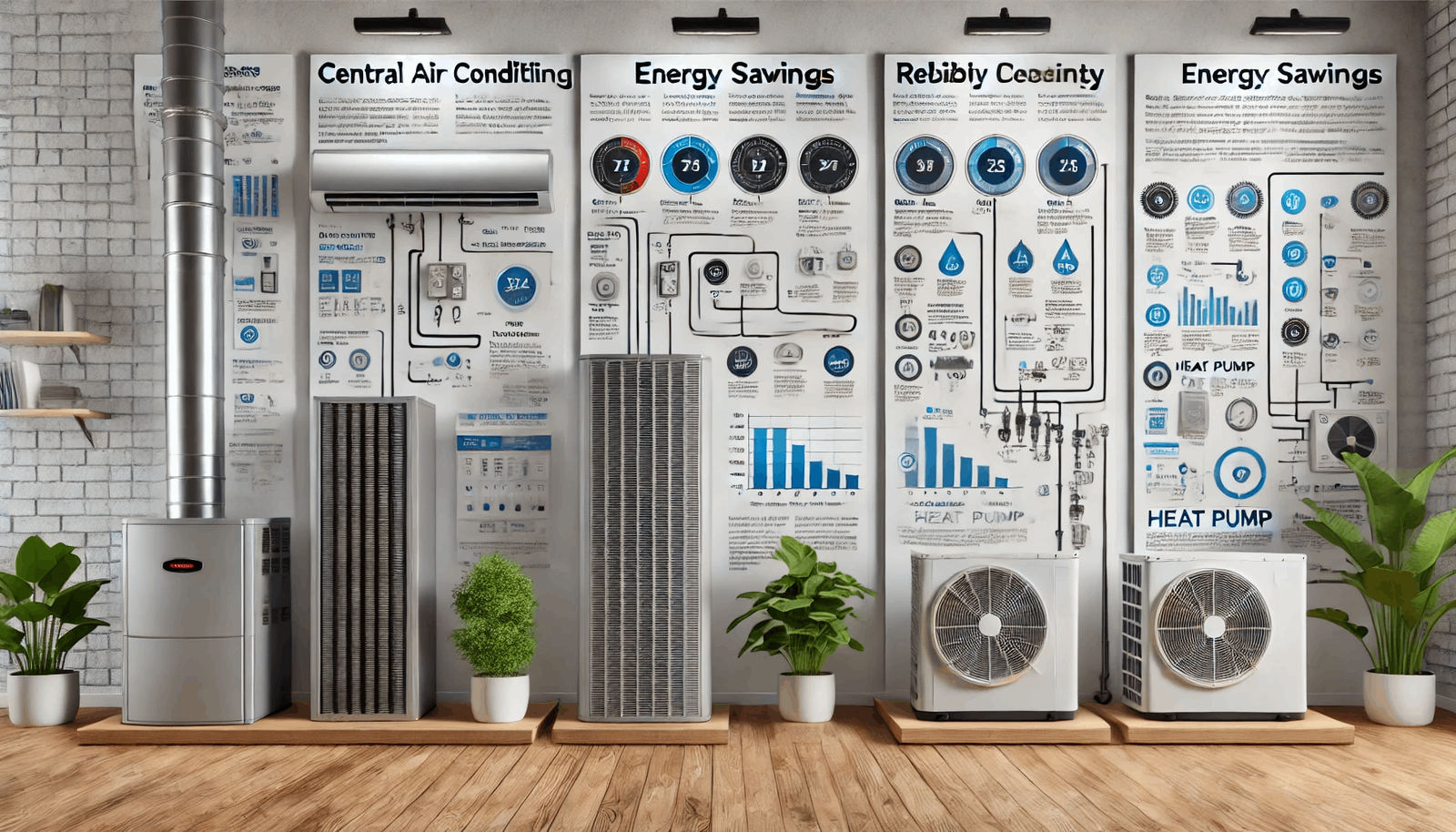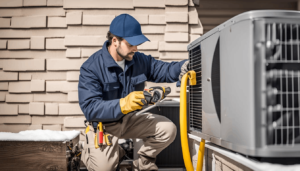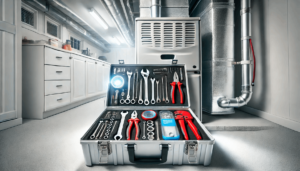Introduction
When it comes to maintaining comfort in your home, having the right heating and cooling system is essential. Whether you live in a cold region that requires efficient heating during winter or in an area that gets sweltering in the summer, selecting the ideal HVAC system can significantly impact your energy bills, home comfort, and even your air quality. With various options available, such as furnaces, heat pumps, and central air systems, it can be challenging to know which solution is best for your home. In this guide, We’ll explore the key factors to consider when choosing heating and cooling services and systems, along with tips on finding top-notch local service providers near you.
Understanding the Basics of Heating and Cooling Systems
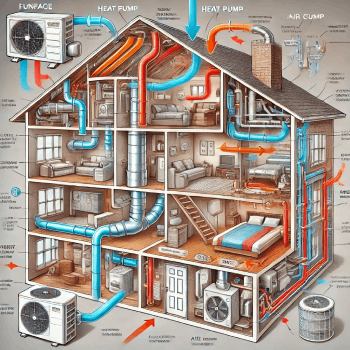
When searching for “heating and cooling services near me,” it’s essential to understand the fundamentals of how these systems work. Whether you’re upgrading your home’s HVAC system or looking for repair services, knowing the basics will help you make an informed decision. Here, we’ll break down what HVAC stands for, how heating and cooling systems function, and the common types of systems available.
What Does HVAC Stand For?
HVAC is an acronym for Heating, Ventilation, and Air Conditioning. It refers to the technology used to control the temperature, humidity, and air quality in residential, commercial, and industrial buildings. These systems are essential for maintaining a comfortable indoor environment throughout the year, no matter the external weather conditions. A well-maintained HVAC system ensures proper ventilation, distributing clean air while maintaining the desired temperature.
How Heating Systems Work in Your Home
Heating systems in HVAC setups work by raising the temperature of your home during colder months. The most common types of heating systems include furnaces, boilers, and heat pumps.
- Furnaces: Furnaces work by heating air and distributing it throughout your home via ducts. The heated air is produced by burning gas, oil, or using electricity as an energy source. Gas furnaces are highly efficient and a popular choice in areas with access to natural gas.
- Boilers: Unlike furnaces, boilers use water to heat your home. They heat water and distribute steam or hot water through pipes and radiators to warm your living spaces. These systems are efficient for homes with radiant floor heating or those that require zoned heating.
- Heat Pumps: Heat pumps are versatile systems that can both heat and cool your home. In the winter, they extract heat from the outdoor air or ground and transfer it indoors. During the summer, they reverse this process to cool your home. Heat pumps are highly energy-efficient, making them a popular option for environmentally-conscious homeowners.
The Role of Cooling Systems in Home Comfort
Cooling systems are just as important as heating, especially during Ontario’s hot summers. These systems work by removing heat from the air inside your home and releasing it outside. The most common cooling system is the air conditioner, which consists of an evaporator, compressor, condenser, and fan.
- Air Conditioners: Central air conditioning systems use a network of ducts to distribute cooled air throughout your home. The system draws warm air from inside, cools it using refrigerants, and sends it back into the living space.
- Ductless Mini-Splits: For homes without ductwork, mini-split systems are an efficient alternative. These systems use an outdoor unit connected to multiple indoor units, allowing individual control over different rooms or zones.
Both systems provide essential comfort during hot months and are crucial for maintaining air quality by dehumidifying the air.
Common Types of HVAC Systems Available
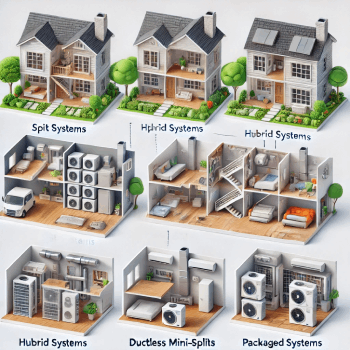
When looking for heating and cooling services near me, it’s important to understand the various types of HVAC systems to choose from. Here are the most common:
- Split System: This is the most traditional HVAC setup, consisting of both an indoor and outdoor unit. The furnace or heat pump is usually inside, while the air conditioner unit is located outside. These systems are effective for homes that require both heating and cooling.
- Hybrid System: A hybrid HVAC system allows for a combination of an electric heat pump and a gas furnace. It provides flexibility, automatically switching between electricity and gas depending on which is more energy-efficient based on the weather.
- Ductless Systems: These systems are designed for homes without traditional ductwork. They are highly efficient and easy to install. Ductless mini-splits can be used to heat or cool specific zones, offering more precise control over the indoor environment.
- Packaged Systems: For homes with limited indoor space, packaged HVAC systems are a good option. These units combine the heating and cooling components in a single outdoor unit, saving space while providing year-round comfort.
By understanding the basics of how heating and cooling systems function, you can make better decisions about what type of system works best for your home’s needs. Whether you’re upgrading an existing HVAC setup or installing a new one, a reliable system ensures year-round comfort and energy efficiency.
Factors to Consider When Choosing a Heating and Cooling System
Choosing the right heating and cooling system for your home is essential for maintaining comfort and energy efficiency. Several factors come into play when making this decision, and understanding these key considerations will help ensure you make the best choice for your home and budget.
Energy Efficiency and Its Impact on Your Bills
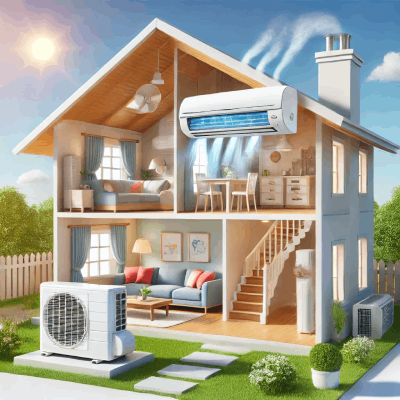
Energy efficiency is one of the most important factors to consider when selecting a heating and cooling system. Systems with higher energy efficiency ratings, such as those certified by ENERGY STAR, are designed to use less energy to provide the same level of heating or cooling. This directly impacts your monthly energy bills, making a high-efficiency system a cost-saving investment in the long run.
For example, modern furnaces and air conditioning units with high SEER (Seasonal Energy Efficiency Ratio) ratings use up to 30-50% less energy than older models, significantly reducing your electricity consumption. Additionally, opting for energy-efficient systems may qualify you for local rebates or incentives, helping offset initial installation costs. This is especially crucial in Ontario, where winters are long, and heating accounts for a large portion of your utility bills.
Size and Layout of Your Home
The size and layout of your home will also determine the type of system that best suits your needs. An improperly sized system—whether too large or too small—can lead to inefficiencies, poor temperature regulation, and increased wear on the unit. An HVAC system that’s too large may cycle on and off frequently, leading to unnecessary energy consumption and wear and tear. On the other hand, a system that’s too small may struggle to maintain the desired temperature, running continuously and driving up energy costs.
Your HVAC provider should conduct a load calculation to determine the appropriate size of your system. Factors such as square footage, ceiling height, the number of windows, insulation levels, and even the number of occupants in the home will impact the ideal size of your heating and cooling unit. A properly sized system ensures consistent comfort and optimal energy use.
Climate Considerations in Ontario
When choosing a heating and cooling system in Ontario, the province’s unique climate should be factored in. With cold, snowy winters and humid summers, residents need a system that can handle a wide range of temperatures. For example, a heat pump can be a great year-round solution in milder regions of Ontario, as it provides both heating and cooling. However, in areas with extremely cold winters, a gas furnace paired with an air conditioner might be more efficient.
If you live in a particularly cold area, choosing a high-efficiency furnace with a high AFUE (Annual Fuel Utilization Efficiency) rating ensures that you are getting the most heat from your fuel source. Meanwhile, areas with hot, humid summers would benefit from an air conditioner with a high SEER rating to cool your home efficiently.
Installation Costs vs. Long-Term Savings
While upfront installation costs are often a major consideration when choosing an HVAC system, it’s important to weigh these costs against long-term savings. A high-efficiency system may have a higher initial price tag, but the savings you achieve on your energy bills over time can more than make up for the initial investment. Additionally, energy-efficient systems typically have longer lifespans and require fewer repairs, resulting in lower maintenance costs.
On the other hand, budget-friendly, lower-efficiency units may seem appealing upfront, but they often result in higher monthly energy bills and more frequent repairs, ultimately costing you more over time. Work with your HVAC provider to balance your immediate budget with the long-term savings potential to make the most cost-effective decision.
Popular Heating and Cooling Options Near Me

When it comes to heating and cooling your home, the options can seem endless. Understanding the different systems available will help you make the best choice based on your needs, preferences, and budget. Here are some of the most common heating and cooling systems you may come across.
Furnaces: Gas, Electric, and Oil Options
Furnaces are among the most popular heating systems for residential homes, particularly in colder climates like Ontario. They work by blowing heated air through ducts, which distribute the warm air to different rooms.
- Gas Furnaces: These are the most common type of furnace, fueled by natural gas. Gas furnaces are known for being efficient and cost-effective, especially in areas with access to natural gas. They heat your home quickly and are relatively easy to maintain.
- Electric Furnaces: Electric furnaces are a good option if your home doesn’t have access to natural gas. While they are typically more expensive to run than gas furnaces, they are easier to install and maintain. Electric furnaces also don’t produce any carbon monoxide, making them safer for indoor air quality.
- Oil Furnaces: Less common today, oil furnaces are still used in rural areas where natural gas might not be available. While oil furnaces can provide a lot of heat, they require more maintenance and can have higher fuel costs compared to gas furnaces.
Heat Pumps: An Energy-Efficient Alternative
Heat pumps are becoming increasingly popular due to their energy efficiency and dual functionality. A heat pump works by transferring heat rather than generating it, making it an environmentally friendly choice. During the winter, it pulls heat from outside and transfers it into your home. In the summer, it reverses the process, removing heat from your home to cool it.
- Air Source Heat Pumps: These heat pumps extract heat from the outside air and are most effective in moderate climates. However, newer models can perform well even in colder conditions, making them suitable for places like Ontario.
- Geothermal Heat Pumps: Also known as ground-source heat pumps, these systems pull heat from the ground rather than the air, making them extremely efficient. While the installation costs are higher, geothermal systems can significantly reduce energy bills over time.
Central Air Conditioning Systems
Central air conditioning systems are the most common cooling systems for homes in Ontario, providing even cooling throughout the house. These systems use ducts to distribute cooled air, making them a great choice for larger homes.
- Efficiency: When choosing a central AC system, look for models with high SEER (Seasonal Energy Efficiency Ratio) ratings. The higher the SEER rating, the more energy-efficient the unit, helping to reduce cooling costs during the hot summer months.
- Upkeep: Central air systems require regular maintenance, such as cleaning or replacing filters, to keep them running efficiently and to maintain indoor air quality.
Ductless Mini-Split Systems
Ductless mini-split systems are gaining popularity as an energy-efficient alternative to traditional central air conditioning systems. These systems consist of an outdoor compressor unit and one or more indoor air-handling units, which can be mounted on walls or ceilings.
- Zoning: One of the biggest advantages of ductless systems is their ability to create “zones” within your home. Each indoor unit can be controlled separately, allowing you to cool or heat only the rooms you’re using, which leads to significant energy savings.
- Installation: Ductless mini-splits are easier to install than central air systems because they don’t require ductwork. This makes them a perfect choice for homes without existing ducts or for those looking to add temperature control to specific areas of their house.
Choosing the Right HVAC Service Provider for Installation and Maintenance
Selecting the right HVAC service provider for installation and maintenance is crucial for ensuring your heating and cooling system works efficiently and lasts longer. Whether you need a new system installed or regular maintenance, it’s essential to find a trusted, qualified professional to meet your needs.
Finding Licensed and Certified HVAC Technicians Near You
When searching for “heating and cooling services near me,” it’s important to look for HVAC companies that employ licensed and certified technicians. In Ontario, HVAC technicians are required to be certified under the Ontario College of Trades, with additional licensing for handling refrigerants, such as an Ozone Depletion Prevention (ODP) certification.
Working with a licensed HVAC technician ensures that the service provider adheres to safety standards and follows industry best practices. Certifications also indicate that the technician is trained in the latest heating and cooling technologies, making them more capable of handling complex installations, repairs, or maintenance tasks.
To verify credentials, ask for proof of licensing and certifications when consulting with a potential HVAC provider. Many companies also display this information on their website, which can give you peace of mind knowing you’re working with qualified professionals.
The Importance of Regular HVAC Maintenance
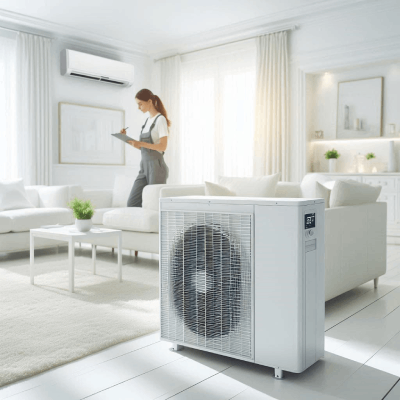
Regular HVAC maintenance is essential to keep your heating and cooling systems running efficiently. A well-maintained HVAC system not only ensures a comfortable indoor environment but also extends the life of the equipment and reduces energy costs. When searching for an HVAC service provider, find a company that offers comprehensive maintenance plans.
Regular maintenance typically includes:
- Inspecting and cleaning the system’s components, such as filters, coils, and blowers.
- Checking for refrigerant leaks and monitoring refrigerant levels.
- Ensuring the thermostat is calibrated for accurate temperature control.
- Verifying the system’s airflow to prevent blockages or inefficiencies.
Routine checkups help prevent breakdowns, improve air quality, and maintain energy efficiency, ultimately lowering your energy bills. Scheduling seasonal maintenance before the heating or cooling season begins can help catch any issues early and prepare your system for increased use.
Checking Customer Reviews and Testimonials
One of the easiest ways to determine the quality of an HVAC service provider is by reading customer reviews and testimonials. Online review platforms like Google Reviews, Yelp, or local directories can offer insights into the experiences of other customers. Pay attention to the company’s ratings, the volume of reviews, and specific feedback related to the company’s response time, professionalism, and the quality of their work.
While reviews can provide valuable insights, it’s also important to look for consistent patterns. If a provider has consistently positive reviews regarding punctuality, expertise, and customer service, they’re likely a good choice for your HVAC needs.
Additionally, ask the company for references. Speaking directly to previous clients can give you a better understanding of how the company operates and whether they are reliable.
How to Compare Local HVAC Service Providers
With so many HVAC companies to choose from, comparing service providers is essential to ensure you get the best deal and service quality. Start by obtaining quotes from multiple providers. A reputable HVAC company will conduct an on-site inspection and provide a detailed estimate, which should include labor, equipment, and any additional costs such as permits or warranties.
When comparing quotes, don’t just focus on price—look at what’s included in the estimate. A lower price may not cover crucial services, while a higher price may offer more comprehensive coverage, such as extended warranties or maintenance plans.
Other factors to consider when comparing HVAC providers include:
- Response time: How quickly can they start the job?
- Service guarantees: Do they offer satisfaction guarantees or follow-up services?
- Availability of emergency services: Can they provide 24/7 emergency support if needed?
By carefully evaluating these factors, you can choose the right HVAC service provider that meets your needs and provides long-term value for your investment.
Conclusion
Choosing the right heating and cooling system for your home is a significant decision that impacts your comfort, energy bills, and overall well-being. By understanding the basics of HVAC systems, considering essential factors like energy efficiency, home size, and local climate, and exploring popular options available, you can make an informed choice that suits your needs.
Whether you opt for a traditional furnace, an energy-efficient heat pump, or a ductless mini-split system, it’s crucial to partner with a qualified HVAC service provider. A licensed technician can ensure proper installation and regular maintenance, maximizing your system’s lifespan and efficiency. Remember to check reviews and testimonials to find a reputable service in your area.
Taking the time to evaluate your options now will lead to a more comfortable and cost-effective home environment in the long run.
Resources
Understanding HVAC Basics and Types of Systems:
- U.S. Department of Energy – Heating and Cooling Systems
- Carrier – What is HVAC? Basics Explained
- Trane – HVAC Systems 101
How Heating and Cooling Systems Work:
- American Society of Heating, Refrigerating and Air-Conditioning Engineers (ASHRAE) – Heating and Cooling Systems Overview
- Popular Mechanics – How Your Home Furnace Works
Energy Efficiency Ratings and Certifications:
- ENERGY STAR – Guide to Energy-Efficient Heating and Cooling
- Natural Resources Canada – Energy Efficiency for Heating and Cooling
Considerations for Choosing the Right HVAC System:
- Lennox – How to Choose the Right HVAC System for Your Home
- Bob Vila – Guide to Choosing the Right HVAC System
HVAC Installation and Maintenance Cost Considerations:
Popular Heating and Cooling System Options:
- U.S. Department of Energy – Furnaces and Boilers
- Energy.gov – Heat Pump Systems
- ENERGY STAR – Ductless Heating and Cooling Systems
Selecting a Qualified HVAC Service Provider:
- Better Business Bureau (BBB) – Choosing an HVAC Contractor
- North American Technician Excellence (NATE) – Why Hire NATE-Certified Technicians
- Ontario College of Trades – HVAC Licensing and Certification Requirements in Ontario
Checking Reviews and Testimonials:
- Google Reviews – Find HVAC Companies with Local Ratings
- Yelp – Read Reviews for Local HVAC Services
- Angi (formerly Angie’s List) – How to Find a Reliable HVAC Contractor
Importance of HVAC Maintenance:

